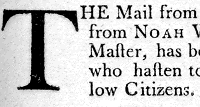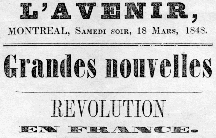




















|
|

Son of George Pascal Desbarats, Queen's printer and publisher of the Foyer canadien, George Edward Desbarats (1838-1893) resuscitated Alexander Sommerville's Canadian Illustrated News which had been published in Hamilton between 1862 and 1864. Modeled on the Illustrated London News, Harper's Weekly and L'Illustration, the Canadian Illustrated News put the emphasis on illustrations using wood-engraving but also the leggotype, the new process of reproducing photographs devised by William Augustus Leggo of Montreal. In the first issue (October 30, 1869), Notman's portrait of Prince Arthur became the first photographic half-tone to appear in the history of journalism. Although its French-language equivalent, L'Opinion publique used many of the same illustrations, it remained a separate entity with its own writers and editorial staff. Of the many illustrators used by Desbarats, Henri Julien (1852-1908) is certainly the most famous. The thousands of illustrations found in these periodicals are one of the main sources for the iconography of the period.
The Canadian Illustrated News.
Montreal, 1869-1883.
L'Opinion publique.
Montréal, 1870-1883.

The prospectus of the Quebec Gazette / Gazette de Québec was probably printed in William Dunlap's Philadelphia shop where William Brown and Thomas Gilmore worked. It was brought to Quebec and distributed by Brown, while his partner went to England to purchase equipment for their printing office. The first issue of the newspaper, the first in Quebec, appeared on June 21, 1764.
William Brown, circa 1737-1789 and Thomas Gilmore, d. 1773
Quebeck: To the Publick / Quebeck: au public.
[Philadelphia: William Dunlap?, 1763 or 1764].

An extraordinary reproducing the text of a letter from Noah Webster, dated Albany, February 2, 1795, and announcing the signing of Jay's Treaty on November 19, 1794.
The news appeared in the British papers, a copy of which was sent on board a ship from Bristol to New York. The ship probably arrived in the middle of January. On January 29, the news was conveyed in a letter by Webster to Albany where it was printed on February 2. A copy was sent to Quebec, arriving between two regular issues of the Times, February 2 and 9. The editor, William Vondenvelden (1753?-1809), judging it an important piece of news, did not wait for the next regular issue (Feb. 9), and had it printed as an extraordinary and sent to his subscribers.
Extraordinary: An item published by a newspaper in-between regular issues. Usually produced during wartime, it contains an announcement or information deemed sufficiently important or time sensitive to warrant immediate publication.
|

|
The Times. Le Cours du temps. 1794-1795.
Quebec: New Printing Office, February 1795.
|

This is John Neilson's printing of a message sent to him by the editors of the Montreal Herald, advising him that on August 25, 1812 they had received a "general order" announcing that General Brock had taken the Fort at Detroit.
|

|
Quebec Gazette
More Glorious.
[Quebec: John Neilson, 1812].
|

This is an interesting example of the progress of a major news story, the 1848 Revolution in France. "The Cambria which left Liverpool on February 27 has arrived and carries very important news which was sent to us by telegraph from Troy. A revolution has broken out in France..." [translation]. Indeed, steamer Cambria left Liverpool on February 27, 1848 and arrived in Halifax on March 15, and then in New York on March 18. It was thanks to the telegraph that this Montreal newspaper received the news from New York state the same day.
|

|
L'Avenir. (1847-1858).
Feuilleton extraordinaire.
Montréal, samedi soir, 18 mars 1848.
|

Example of live reporting, hour by hour, of the battles of the Canadian troops against the Fenians at Frelighsburg and Cook Corners. The arrest of General O'Neil is also recorded in detail.
Le Pays. Montréal, 1852-1871.
Bulletin de jeudi, Montréal 26 mai 1870: dernières nouvelles de la frontière: mouvements féniens!
[Montreal, 1870].

This newspaper was printed for Canadian soldiers in Caen (France) from July 27, 1944 to September 1944, and subsequently printed in Brussels until September 1945. Another edition had been printed in Italy beginning in January 1944. The ration was limited to one copy per seven soldiers.
The Maple Leaf.
[Caen, France], 27 July 1944 - September 1944.

|
